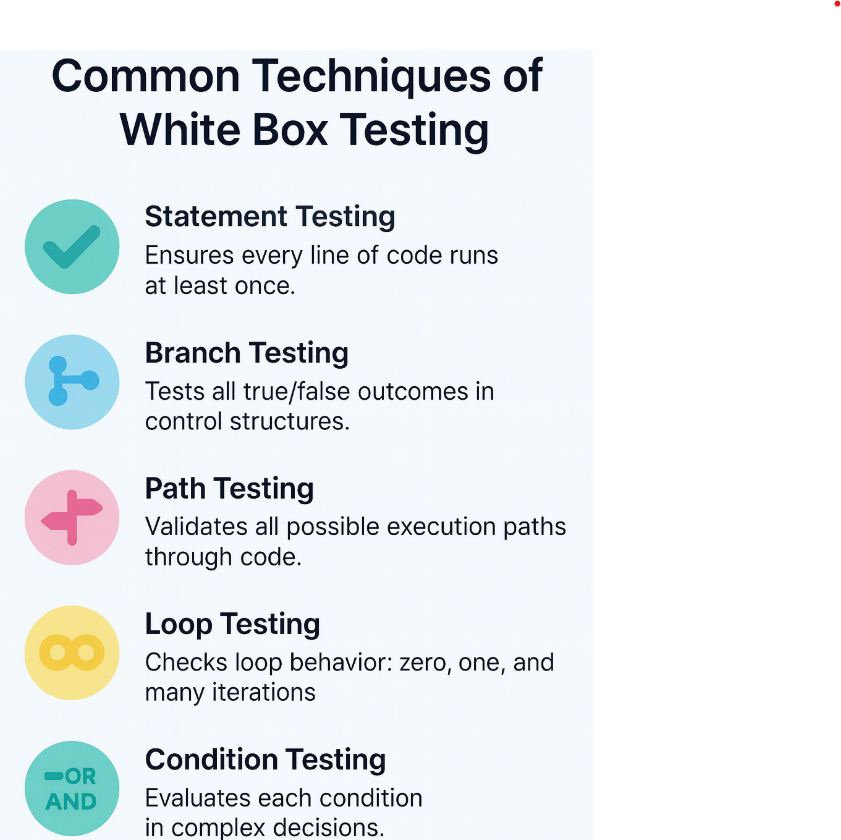What Is White Box Testing? Benefits, Tools, and How It Works
Sometimes the code runs. The tests pass. Nothing crashes. And yet something feels off!
It might be a logic path no one thought to test. Or a condition that works until it doesn’t. These are the bugs that don’t wave red flags. They hide behind “expected behavior.”
White box testing helps you find them. It’s not about the interface or the output. It’s about what’s happening inside- how data flows, how decisions are made, and whether the code is doing what it’s supposed to under the hood.
This guide breaks down how white box testing works, where it fits into your QA workflow, and why it’s becoming a must-have for teams aiming for real coverage not just checkbox testing.
What Is White Box Testing?
Think of your application like a house. Black box testing checks if the lights turn on when you flip the switch. White box testing? It opens the walls and looks at the wiring.
At its core, white box testing is about checking how your code actually works. You’re looking at logic flows, conditionals, loops, and how data moves through the system. It's sometimes called structural or clear box testing for that reason: you have full visibility into the code.
Instead of just asking, “Did the output match the expectation?”, you’re asking, “Did it get there for the right reason?”
This kind of testing is usually done by developers or SDETs, but that’s changing. More QA teams are starting to use it too, especially with better tooling and the push toward shift-left testing.
Where Does It Fit in the Testing Lifecycle?
White box testing usually happens early close to the code, before things get too polished. You’ll mostly see it during:
- Unit testing – when devs want to check if small pieces of code (like a function or a class) behave the way they should.
- Integration testing – when different parts of the system start talking to each other, and you want to make sure internal logic doesn’t get lost in translation.
- Regression testing – when you make changes and need to be sure nothing broke behind the scenes.
Read More: A complete guide to regression testing and why it matters.
White Box vs. Black Box vs. Gray Box Testing
Here’s a quick look at how white box testing compares to black box and gray box approaches-
| Aspect | White box Testing | Black box Testing | Gray box Testing |
|---|---|---|---|
| Knowledge of Code | Full access to internal code and logic | No access to internal code | Partial knowledge of architecture |
| Focus Area | Logic paths, loops, branches, data flow | Functionality, UI behavior, end-user flow | Integration points, security, workflows |
| Performed By | Developers or SDETs | Testers or QA engineers | Both developers and testers |
| Best For | Unit testing, code coverage, logic testing | System testing, acceptance testing | Security testing, integration scenarios |
| Test Design Basis | Internal code structure | Functional specifications | Architecture + limited internal knowledge |
| Tools Commonly Used | JaCoCo, SonarQube, PVS-Studio | Selenium, Postman, TestComplete | Burp Suite, Cypress |
| Automation Fit | High (CI/CD, static analysis) | High (UI, API automation) | Medium–High (depends on access level) |
What Exactly Does White Box Testing Look At?
White box testing goes straight into the source code and focuses on how different parts work under the hood. Here's what testers usually examine:
- Control structures: Loops, conditionals, and decision logic.
- Code paths: Every possible route the program can take.
- Data flow: How variables are initialized, modified, and passed.
- Logic errors: Unexpected behavior, dead code, or missed edge cases.
Think of it as checking not just what the app does, but making sure the wiring behind it is sound.
Key Techniques in White Box Testing
You don’t need to be a coding expert to run white box tests but you do need to know what you’re testing for. Here are a few techniques we’ve leaned on over the years:

Unit-Level Techniques
- Unit Testing: The bread and butter. Test one function. Make sure it doesn’t do something weird when you give it edge-case input.
- Loop Testing: Try that same function with no loop, one loop, 100 loops. You’d be surprised how many bugs live in repetition.
Logic-Based Techniques
- Branch Testing: Every "if", "else", and "maybe" should get hit. Think of it as making sure no logic path gets lonely.
- Condition Testing: Got compound logic? (like if A && B || C) Test every combo. That’s where sneaky bugs hide.
- Path Testing: Cover as many possible routes as you can without overdoing it. You don’t need to test every blade of grass, just the trail.
Techniques
- Statement Testing: Did your test actually run this line of code? Coverage tools will tell you. Low numbers here? You’ve got gaps.
Why Teams Benefit from White Box Testing
White box testing may take more effort upfront but the return is well worth it. Here’s why it belongs in your QA toolkit:
- It catches bugs earlier: The annoying ones that pop up in conditionals, logic paths, or weird loops? You’ll find them here before they cause real damage.
- It makes code cleaner: Writing tests forces devs to look at their logic more critically. We’ve seen devs simplify or refactor on the spot while writing tests.
- It adds confidence: You’re not just guessing that your code works- you’re proving it, path by path.
- Integrates into CI/CD pipelines: It fits naturally into automated CI/CD workflows, providing fast feedback with every code change.
- It improves security: Vulnerabilities often hide in logic. This testing method helps expose risky flows before attackers do.
How to Perform White Box Testing
If you’re wondering where to even start with white box testing, don’t worry—it’s not as complex as it sounds. Here’s how most teams (ours included) usually go about it:
- Read the code: Seriously. That’s step one. Before you write a single test, spend some time with the logic. Look for conditions, branches, loops—anything that feels messy or fragile.
- Spot high-risk logic: Not all code needs deep testing. Look for areas that are complex, used often, or likely to break if someone sneezes near them. That’s where your effort will pay off the most.
- Write specific test cases: No generic tests here. You want tests that walk through each meaningful logic path. Got a loop? What happens with zero iterations?
- Run the tests: You can run them manually, but honestly, automation is your friend here. Most teams plug white box tests straight into their CI/CD pipeline for fast feedback.
- Measure your coverage: Use tools like JaCoCo or SonarQube to see what got tested and what didn’t. A coverage report won’t solve your problems but it shows you where to look.
- Keep your tests fresh: Code evolves. Tests break. That’s normal. But if you don’t update your tests along the way, you’ll end up with false positives or worse, blind spots.
Challenges & Limitations of White Box Testing
White box testing has a lot going for it but it’s not always easy. Here are a few pain points we’ve run into (and how we deal with them):
- It takes time upfront: Writing white box tests isn’t a “click and go” job. Especially with legacy code, you can lose hours trying to wrap your head around logic that hasn’t been touched in years.
- You need to understand the code: This isn’t something you can fully hand off to someone without technical depth. Testers need to work closely with devs or become part dev themselves.
- It needs maintenance: White box tests break when code changes. That’s just part of the deal. But the longer you wait to fix them, the messier it gets.
- It doesn’t catch everything: This one surprises people. But it’s true white box testing won’t tell you if the UI breaks or if the user flow feels clunky. It’s not designed for that.
Tools & Automation in White Box Testing
You don’t have to do it all manually. Modern tools make it much easier to bake white box testing into your day-to-day workflow.
Common Tools Teams Use:
- JaCoCo: For tracking code coverage in Java projects. Works well with build tools like Maven or Gradle.
- SonarQube: Helps with static code analysis, highlighting vulnerabilities and maintainability issues.
- PVS-Studio: A robust tool for detecting complex bugs, especially in large enterprise systems.
- Checkmarx: Security-focused, often used in environments with high compliance standards.
Where DevAssure Comes In
We built DevAssure to make white box testing less painful and actually useful for fast-moving teams.
- It auto-generates test scaffolds from your code, so you're not writing every test by hand.
- It flags untested logic paths—no more guesswork.
- It plugs into your CI/CD and runs quietly in the background.
- And it scales. Whether you’ve got 3 devs or 30, the feedback loop stays tight.
No bloated setup. No separate dashboards. Just code-level testing that fits into your workflow.
Wondering about features, pricing, or how the product works? We’re happy to walk you through it. Chat with our team.
Best Practices for Enterprises
White box testing works best when it’s focused, not forced. Here’s what’s helped us and other teams scale it without burning out:
- Start with the riskiest code: Not everything needs deep testing. Focus on business-critical logic or areas that break often.
- Bake it into CI/CD early: Don’t treat it as an afterthought. Tests should run with every commit without exception.
- Don’t chase 100% coverage: It sounds impressive but often leads to bloated tests. Aim for useful coverage, not perfect numbers.
- Keep tests clean: Small, focused, and easy to update. Messy tests won’t survive long in fast-moving teams.
- Automate where it counts: Use tools that reduce manual work but still give you control over logic testing.
Read More: Explore the key differences between manual and automation testing and how to choose the right approach for your QA strategy.
Future Trends & The Role of AI
White box testing is evolving and AI is leading the transformation. Now, tools can:
- Auto-generate smart test cases based on your code structure and recent changes
- Spot logic gaps before they cause issues
- Understand intent, not just syntax, thanks to large language models
What does that mean for teams? Fewer repetitive chores. Faster feedback. And testing that keeps up with rapid releases.
We’re already building toward this at DevAssure with AI agents that don’t just help you write tests, but manage them across the lifecycle. The future? White box testing that thinks a step ahead of you.
Related Read: Check out how AI is accelerating test automation and helping teams move faster with smarter, context-aware test coverage.
Still Wondering If White Box Testing Is Worth It?
White box testing isn’t always easy but the payoff is real. It shines a light on what most tests miss: logic bugs, fragile paths, and hidden risks that can quietly break your product.
It’s not about writing more tests—it’s about writing the right ones. Done well, white box testing brings clarity, confidence, and fewer surprises in production.
And with tools like DevAssure, you can integrate it without slowing down.
🚀 See how DevAssure accelerates test automation, improves coverage, and reduces QA effort.
Ready to transform your testing process?
